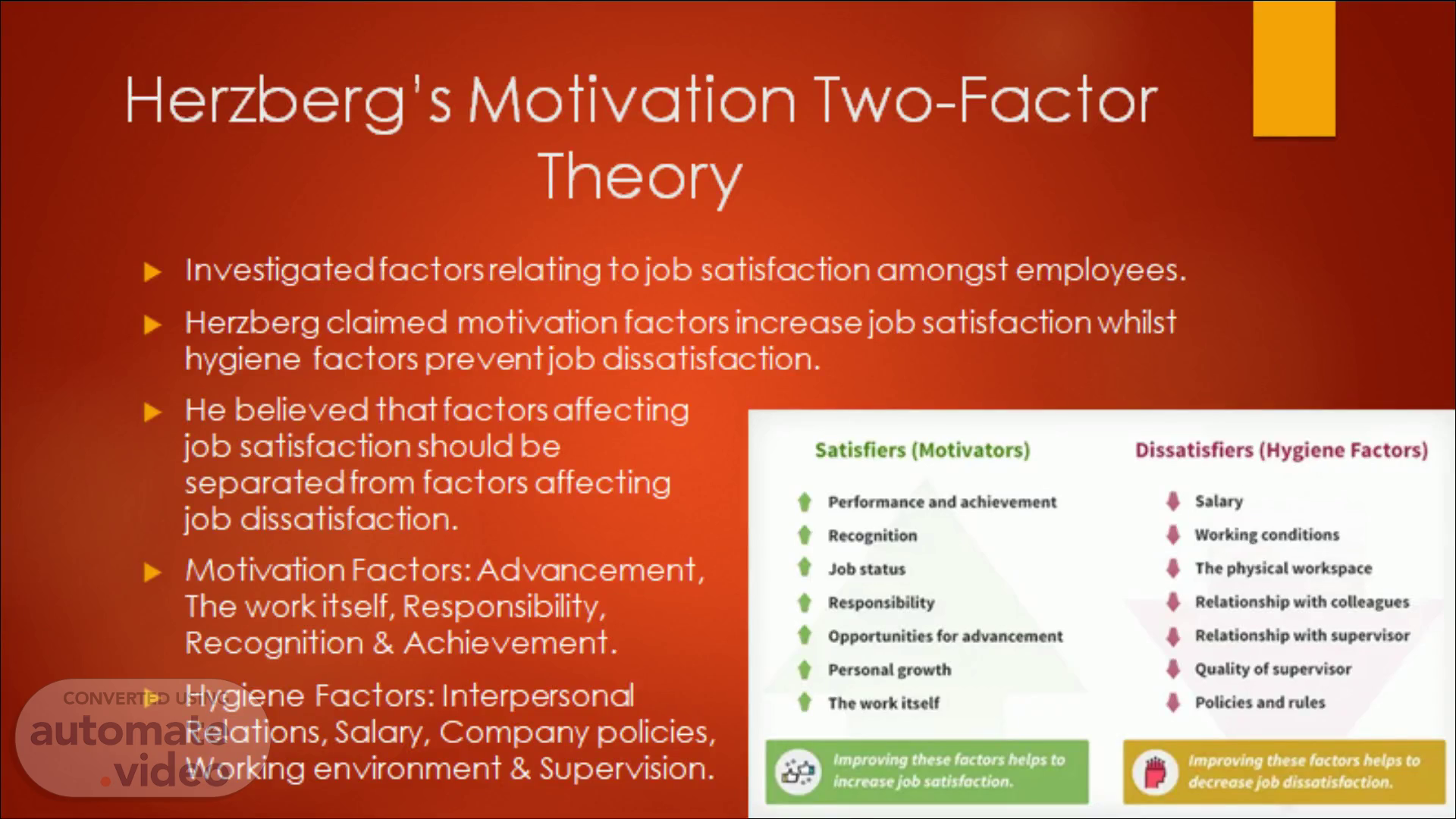
BU4001 Group presentation
Scene 1 (0s)
. . qotivation Two-Factor Theory relating to job satisfaction amongst employees. otivation factors increase job satisfaction whilst vent job dissatisfaction. )tors affecting 'ld be •ors affecting Advancement, Dnsibllity, wement. erpersond mpany policies, & Supervision. Satisfiers (Motivators) and achievement Job status Opportunities for advancement Personal growth The work itself Improving these factors helps to increasejob satisfaction. Dissatisfiers (Hygiene Factors) Salary Working conditions The physical Relationship with cotteagues Relationship With supervisor Quality of supervisor Policies and rules Improving these foetors helps to decrease job dissotisfoction,.
Scene 2 (45s)
. .
Scene 3 (50s)
[Audio] Skinner's Reinforcement Theory ( 1938) • There are four main methods for influencing behaviour: - Positive reinforcement encourages behaviour with a positive response ( e.g., praise for coming to work early.) - Negative reinforcement encourages behaviour by removing consequences (e.g., a manager doesn't have to nag the employee.) - Punishment can encourage or discourage behaviour either through negative consequences or removal of positive consequences (e.g., employee gets disciplined by manager, or gets demoted.) - Extinction involves not giving a consequence or response for a behaviour, discouraging it (e.g., ignoring an employee putting in extra work will lead to employee seeing extra work as pointless.) • Skinner's Reinforcement Theory uses punishment and reinforcement to adjust employee behaviour. Something is added Something is taken away Encourages behaviour Positive Reinforcement ( Praise) Negative Reinforcement (Not nagged by boss) Discourages behaviour Positive Punishment (Disciplinary action) Negative Punishment (Demoted).
Scene 4 (2m 22s)
[Audio] In Practice: • John's manager likes to yell at him when he doesn't submit his reports. This time, John got his report finished ahead of time to avoid being yelled at. • Jane's company offers bonus holiday time to staff who meet a sales quota. Jane works hard to beat her quota so she can take a summer holiday. NEGATIVE REINFORCEMENT! POSITIVE REINFORCEMENT!.
Scene 5 (2m 56s)
. Adam's Equity Theory (1963) The equity theory suggests that people are driven by fairness (Vidya Hattangadi, 2019) This theory identifies itself with two keywords, 'inputs' and 'outputs'; the inputs beingwhat an individual puts into their task and outputs being the rewards they receive (Jessie Banks, Cynthia Patel, Moola J & A Mohammed, 2012). Positives: What I put into my job Time effort, ability, loyalty Inputs What I get from my job Pay, bonus, perks, benefits Outputs (Manu MelwinJoy, 2018) • Helpsto limit mistreatment—the equitytheory helpsto prevent company discrimination towardstheir employees, e.g. workers doingthe same job but on different pay grade (Vinish Parikh, 2019). • Employees in the organization get 'things' forhelpingthe organizations hita goal —these 'things' may be stufflike extra time off or a bonus (World of Work Project, 2021). • Other inputsthis theory allows includes; loyalty, hard work, commitment, determination and acceptance of others (Mind Tools Content Team, 2018) Negatives— Difference in perception —the theory may lead to challenge in opinion about perception such as individual differences, this could be between employee and employer or between different employees in the company (Hitesh Bhasin, 2020). • individual competition—the formula for equitytheory can suggests that individualsare competition fora fixed or limited result that individuals can take different credit for based on their inputs (Daniel Romer, 1977)..
Scene 6 (3m 45s)
. Hi everyone, ilm going to introduce a chart 11 C' CREATED USING 4 POWTOOn.
Scene 7 (3m 53s)
. The chart will measure when an individual hits targets such as selling 50 magazines 1 O CREATED USING 4 POWTOOn.
Scene 8 (4m 1s)
. I have sold all my magazines for this CREATED USING 4 POWTOOn.
Scene 9 (4m 9s)
. Thank you, all my hard work has been recognised Congratulations in hitting all your targets, you will receive a bonus in your next pay for all your good work l. C' CREATED USING 4 POWTOOn.
Scene 10 (4m 20s)
[Audio] Vrooms Theory: In Practice Money Time off Valence: the personal value of the reward in the event of achieving the proposed outcome. Instrumentality: the belief that they will receive the rewards. Expectancy: the desired results are achievable and support is available if needed..
Scene 11 (4m 47s)
[Audio] Victor Vroom's Expectancy Theory Motivation Valence Instrumentality Expectancy Valence: the personal value of the reward in the event of achieving the proposed outcome. Instrumentality: the belief that they will receive the rewards. Expectancy: the desired results are achievable and support is available if needed..
Scene 12 (5m 19s)
. . References. Clayton, Mike. (2020, January 30). Victor Vroom and Expectancy Theory: Process of Model of Motivation [Video]. YouTube. https://www.youtube.com/watch?v=WDgF7Avijlc.